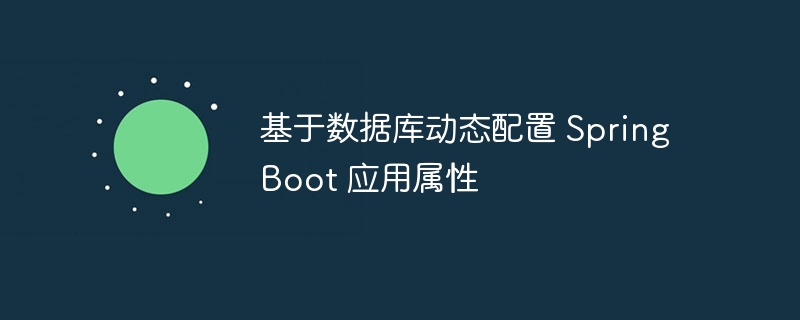动态配置SpringBoot属性的数据库方法
时间:2025-08-23 22:42:50 477浏览 收藏
本文深入探讨了如何利用数据库实现 Spring Boot 应用属性的动态配置,旨在解决传统配置方式需要重启服务器的问题。文章核心在于自定义 `PropertySource`,将数据库中的配置信息无缝集成到 Spring 的属性管理体系中,从而实现配置的动态更新与管理。通过创建数据库实体类、DAO 接口,以及自定义 `DynamicConfigPropertySource`,并将其注册到 Spring 的 `Environment` 中,应用便能像使用 `application.properties` 文件一样,通过 `@Value` 注解或 `Environment` 对象访问数据库中的配置信息。该方案显著提升了 Spring Boot 应用的灵活性和可维护性,尤其适用于需要频繁调整配置的场景。

本文旨在提供一种解决方案,允许 Spring Boot 应用从数据库动态加载和配置属性,从而避免每次修改配置都需要重启服务器。通过自定义 PropertySource,我们可以将数据库中的配置项集成到 Spring 的属性管理体系中,实现配置的动态更新和管理。
实现原理
核心思想是创建一个自定义的 PropertySource,该 PropertySource 从数据库读取配置信息,并将其暴露给 Spring 的 Environment。 Spring 在启动时会加载所有的 PropertySource,并将其中的属性合并到一个全局的属性集合中。 这样,我们就可以像使用 application.properties 文件一样,使用 @Value 注解或 Environment 对象来访问数据库中的配置信息。
具体步骤
创建数据库实体类:
首先,我们需要创建一个实体类来映射数据库中的配置表。该表至少应包含 key 和 value 两列,分别用于存储配置项的名称和值。
import lombok.Getter; import lombok.Setter; import javax.persistence.*; @Setter @Getter @Entity @Table(name = "t_dynamic_config") public class DynamicConfig { @Id @GeneratedValue(strategy = GenerationType.IDENTITY) private Integer id; private String key; private String value; }说明:
- @Entity 和 @Table 注解用于将该类映射到数据库中的 t_dynamic_config 表。
- @Id 和 @GeneratedValue 注解用于指定主键和主键生成策略。
- key 和 value 字段分别用于存储配置项的名称和值。
- @Getter 和 @Setter 注解来自 Lombok 库,用于自动生成 getter 和 setter 方法,简化代码。
创建 DAO 接口:
接下来,我们需要创建一个 DAO(Data Access Object)接口,用于访问数据库中的配置信息。 我们使用 Spring Data JPA 来简化数据库访问。
import org.springframework.data.jpa.repository.JpaRepository; public interface DynamicConfigDao extends JpaRepository<DynamicConfig,Integer> { DynamicConfig findByKey(String key); }说明:
- JpaRepository 接口提供了常用的数据库操作方法,如 findAll()、findById()、save() 等。
- findByKey() 方法用于根据配置项的名称查找配置信息。 Spring Data JPA 会自动根据方法名生成 SQL 查询语句。
创建自定义 PropertySource:
现在,我们需要创建一个自定义的 PropertySource,该 PropertySource 从数据库读取配置信息,并将其暴露给 Spring 的 Environment。
import org.springframework.core.env.EnumerablePropertySource; public class DynamicConfigPropertySource extends EnumerablePropertySource<DynamicConfigDao> { public DynamicConfigPropertySource(String name, DynamicConfigDao source) { super(name, source); } @Override public String[] getPropertyNames() { return getSource().findAll().stream().map(DynamicConfig::getKey).toArray(String[]::new); } @Override public Object getProperty(String name) { return getSource().findByKey(name).getValue(); } }说明:
- EnumerablePropertySource 是 Spring 提供的一个抽象类,用于实现可枚举的 PropertySource。
- getPropertyNames() 方法返回所有配置项的名称。
- getProperty() 方法根据配置项的名称返回配置值。
注册自定义 PropertySource:
最后,我们需要将自定义的 PropertySource 注册到 Spring 的 Environment 中。 我们可以在 Spring Boot 应用的启动类中注册 PropertySource。
import org.springframework.beans.factory.SmartInitializingSingleton; import org.springframework.beans.factory.annotation.Autowired; import org.springframework.boot.SpringApplication; import org.springframework.boot.autoconfigure.SpringBootApplication; import org.springframework.context.annotation.Component; import org.springframework.core.env.ConfigurableEnvironment; @SpringBootApplication public class TestApplication { public static void main(String[] args) { SpringApplication.run(TestApplication.class, args); } @Component static class ConfigDynamicConfigPropertySource implements SmartInitializingSingleton { @Autowired private ConfigurableEnvironment environment; @Autowired private DynamicConfigDao dynamicConfigDao; @Override public void afterSingletonsInstantiated() { environment.getPropertySources().addLast(new DynamicConfigPropertySource("db_source",dynamicConfigDao)); } } }说明:
- SmartInitializingSingleton 接口用于在所有单例 bean 初始化完成后执行回调方法。
- afterSingletonsInstantiated() 方法在所有单例 bean 初始化完成后被调用。
- environment.getPropertySources().addLast() 方法将自定义的 PropertySource 添加到 Environment 的属性源列表中。
使用方式
完成以上步骤后,我们就可以像使用 application.properties 文件一样,使用 @Value 注解或 Environment 对象来访问数据库中的配置信息。
import org.springframework.beans.factory.annotation.Value;
import org.springframework.stereotype.Component;
@Component
public class MyComponent {
@Value("${my.dynamic.property}")
private String myDynamicProperty;
public String getMyDynamicProperty() {
return myDynamicProperty;
}
}说明:
- @Value("${my.dynamic.property}") 注解用于将 my.dynamic.property 配置项的值注入到 myDynamicProperty 字段中。
- 如果数据库中不存在 my.dynamic.property 配置项,则 myDynamicProperty 字段的值为 null。
注意事项
- 确保数据库连接配置正确。
- 确保数据库表结构与实体类定义一致。
- PropertySource 的名称应具有唯一性,避免与其他 PropertySource 冲突。
- 在生产环境中,建议使用缓存来提高性能,避免频繁访问数据库。
- 如果配置项的值发生变化,需要手动刷新 Environment,才能使新的配置生效。 可以通过 Spring 的 ContextRefresher 来实现配置的动态刷新。
总结
本文介绍了一种基于数据库动态配置 Spring Boot 应用属性的解决方案。 通过自定义 PropertySource,我们可以将数据库中的配置项集成到 Spring 的属性管理体系中,实现配置的动态更新和管理。 这种方案可以提高应用的灵活性和可维护性,避免每次修改配置都需要重启服务器。
今天关于《动态配置SpringBoot属性的数据库方法》的内容就介绍到这里了,是不是学起来一目了然!想要了解更多关于的内容请关注golang学习网公众号!
-
501 收藏
-
501 收藏
-
501 收藏
-
501 收藏
-
501 收藏
-
107 收藏
-
362 收藏
-
281 收藏
-
229 收藏
-
166 收藏
-
287 收藏
-
136 收藏
-
308 收藏
-
249 收藏
-
495 收藏
-
175 收藏
-
466 收藏
-

- 前端进阶之JavaScript设计模式
- 设计模式是开发人员在软件开发过程中面临一般问题时的解决方案,代表了最佳的实践。本课程的主打内容包括JS常见设计模式以及具体应用场景,打造一站式知识长龙服务,适合有JS基础的同学学习。
- 立即学习 543次学习
-

- GO语言核心编程课程
- 本课程采用真实案例,全面具体可落地,从理论到实践,一步一步将GO核心编程技术、编程思想、底层实现融会贯通,使学习者贴近时代脉搏,做IT互联网时代的弄潮儿。
- 立即学习 516次学习
-

- 简单聊聊mysql8与网络通信
- 如有问题加微信:Le-studyg;在课程中,我们将首先介绍MySQL8的新特性,包括性能优化、安全增强、新数据类型等,帮助学生快速熟悉MySQL8的最新功能。接着,我们将深入解析MySQL的网络通信机制,包括协议、连接管理、数据传输等,让
- 立即学习 500次学习
-

- JavaScript正则表达式基础与实战
- 在任何一门编程语言中,正则表达式,都是一项重要的知识,它提供了高效的字符串匹配与捕获机制,可以极大的简化程序设计。
- 立即学习 487次学习
-

- 从零制作响应式网站—Grid布局
- 本系列教程将展示从零制作一个假想的网络科技公司官网,分为导航,轮播,关于我们,成功案例,服务流程,团队介绍,数据部分,公司动态,底部信息等内容区块。网站整体采用CSSGrid布局,支持响应式,有流畅过渡和展现动画。
- 立即学习 485次学习
